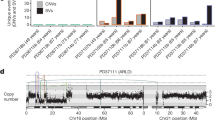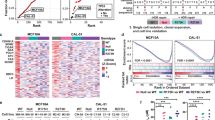Abstract
Structural mutations in the p53 gene are seen in virtually every form of human cancer. To determine whether such mutations are important for initiating tumorigenesis, we have been studying hepatocellular carcinoma, in which most cases are associated with chronic hepatitis B virus infections. Using a transgenic mouse model where expression of a single HBV gene product, the HBx protein, induces progressive changes in the liver, we show that tumour development correlates precisely with p53 binding to HBx in the cytoplasm and complete blockage of p53 entry into the nucleus. Analysis of tumour cell DMA shows no evidence for p53 mutation, except in advanced tumours where a small proportion of cells may have acquired specific base substitutions. Our results suggest that genetic changes in p53 are late events which may contribute to tumour progression.
This is a preview of subscription content, access via your institution
Access options
Subscribe to this journal
Receive 12 print issues and online access
$209.00 per year
only $17.42 per issue
Buy this article
- Purchase on Springer Link
- Instant access to full article PDF
Prices may be subject to local taxes which are calculated during checkout
Similar content being viewed by others
References
Harris, C.C. & Hollstein, M. Clinical implications of the p53 tumor-suppressor gene. New Engl. J. Med. 329, 1318–1327 (1993).
Jay, G. et al. A common transformation-related protein in murine sarcomas and leukemias. Cold Spring Harbor Symp. Quant. Biol. 44, 659–664 (1979).
DeLeo, A.B. et al. Detection of a transformation-related antigen in chemically induced sarcomas and other transformed cells of the mouse. Proc. natn. Acad. Sci. U.S.A. 76, 2420–2424 (1979).
Lane, D.P. & Crawford, L.V. T Antigen is bound to a host protein in SV40-transformed cells. Nature 278, 261–263 (1979).
Linzer, D.I. & Levine, A.J. Characterization of a 54K dalton cellular SV40 tumor antigen present in SV40-transformed cells and uninfected embryonal carcinoma cells. Cell 17, 43–52 (1979).
Dippold, W.G., Jay, G., DeLeo, A.B., Khoury, G. & Old, L.J. p53transformation-related protein: Detection by monoclonal antibody in mouse and human cells. Proc. natn. Acad. Sci. U.S.A. 78, 1695–1699 (1981).
Crawford, L.V., Pim, D.C., Gurney, E.G., Goodfellow, P. & Taylor-Papadimitriou, J. Detection of a common feature in several human tumor cell lines — a 53,000-dalton protein. Proc. natn. Acad. Sci. U.S.A. 78, 41–45 (1981).
Sarnow, P., Ho, Y.S., Williams, J. & Levine, A.J., Adenovirus E1b-58 kd tumor antigen and SV40 large tumor antigen are physically associated with the same 54 kd cellular protein in transformed cells. Cell 28, 387–394 (1982).
Szekely, L., Selivanova, G., Magnusson, K.P., Klein, G. & Wiman, K.G. EBNA-5, an Epstein-Barrvirus-encoded nuclear antigen, binds to the retinoblastoma and p53 proteins. Proc. natn. Acad. Sci. U.S.A. 90, 5455–5459 (1993).
Werness, B.A., Levine, A.J. & Howley, P.M. Association of human papillomavlrus types 16 and 18 E6 proteins with p53. Science 248, 76–79 (1990).
Feitelson, M.A., Zhu, M., Duan, L.X. & London, W.T. Hepatitis Bx antigen and p53 are associated in vitro and in liver tissues from patients with primary hepatocellular carcinoma. Oncogene 8, 1109–1117 (1993).
Levine, A.J., Momand, J. & Findlay, C.A. The p53 tumour suppressor gene. Nature 351, 453–456 (1991).
Momand, J., Zambetti, G.P., Olson, D., George, D.L. & Levine, A.J. The mdm-2 oncogene product forms a complex with the p53 protein and Inhibits p53-mediated transactivation. Cell 69, 1237–1245 (1992).
Barak, Y. & Oren, M. Enhanced binding of a 95 kDa protein to p53 in cells undergoing p53-mediated growth arrest. EMBO J. 11, 2115–2121 (1992).
Pietenpol, J.A. & Vogelstein, B. Tumour suppressor genes: no room at the p53 inn. Nature 365, 17–18 (1993).
Beasley, R.P. & Hwang, L.Y. in Viral hepatitis and liver disease. (eds Vyas, G.N.,Dienstag. J.L. & Hoofnagle, J.H.) 209–224 (Grune & Stratton, NewYork, 1984).
Tiollais, P., Pourcel, C. & Dejean, A. The hepatitis B virus. Nature 317, 489–495 (1985).
Popper, H., Shafritz, D.A. & Hoofnagle, J.H. Relation of the hepatitis B virus carrier state to hepatocellular carcinoma. Hepatology 7, 764–772 (1987).
Hsu, I.C., Metcalf, R.A., Sun, T., Welsh, J.A., Wang, N.J. & Harris, C.C. Mutational hotspot in the p53 gene in human hepatocellular carcinomas. Nature 350, 427–428 (1991).
Bressac, B., Kew, M.C., Wand, J.R. & Ozturk, M. Selective G to T mutations of p53 gene in hepatocellular carcinoma from southern Africa. Nature 350, 429–431 (1991).
Hosono, S., Lee, C.-S., Chou, M.-J., Yang, C.-S. & Shin, C. Molecular analysis of the p53 alleles In primary hepatocellular carcinomas and cell lines. Oncogene 6, 237–243 (1991).
Buetow, K.H., Sheffield, V.C., Zhu, M., Zhou, T., Shen, M.F. & Hino, O. Low frequency of p53 mutations observed in a diverse collection of primary hepatocellular carcinomas. Proc. natn. Acad. Sci. U.S.A. 89, 9622–9626 (1992).
Sheu, J.C., Huang, G.T., Lee, P.H., Chung, J.C., Chou, H.C. & Lai, M.Y. Mutation of p53 gene in hepatocellular carcinoma in Taiwan. Cancer Res. 52, 6098–6100 (1992).
Nishida, N., Fukuda, Y., Kokuryu, H., Toguchida, J., Yandell, D.W. & Ikenega, M. Role and mutational heterogeneity of the p53 gene in hepatocellular carcinoma. Cancer Res. 53, 368–372 (1993).
Unsal, H., Yakicier, C., Marcais, C., Kew, M., Volkmann, M. & Zentgraf, H. Genetic heterogeneity of hepatocellular carcinoma. Proc. natn. Acad. Sci. U.S.A. 91, 822–826 (1994).
Twu, J.S. & Schloemer, R.H. Transcriptional trans-activating function of hepatitis B virus. J. Virol. 61, 3448–3453 (1987).
Seto, E., Yen, T., Peterlin, B.M. & Ou, J. Trans-activation of the human immunodeficiency virus long terminal repeat by the hepatitis B virus X protein. Proc. natn. Acad. Sci. U.S.A. 85, 8286–8290 (1988).
Spandau, D.F. & Lee, C.H. Trans-activation of viral enhancers by the hepatitis B virus X protein. J. Virol. 62, 427–434 (1988).
Colgrove, R., Simon, G. & Ganem, D. Transcriptional activation of homologous and heterologous genes by the hepatitis B virus X gene product in cells permissive for viral replication. J. Virol. 63, 4019–4026 (1989).
Kim, C.-M., Koike, K., Saito, I., Miyamura, T. & Jay, G., The HBx gene of hepatitis B virus induces liver cancer in transgenic mice. Nature 351, 317–320 (1991).
Lee, T.-H., Finegold, M.J., Shen, R.F., DeMayo, J.L., Woo, S.L.C. & Butel, J.S. Hepatitis B virus transact!vator X protein is not tumorigenic In transgenic mice. J. Virol. 64, 5939–5947 (1990).
Feitelson, M.A. & Clayton, M.M. X antigen polypeptides in the sera of hepatitis B virus-infected patients. Virology 177, 367–371 (1990).
Kekule, A.S., Lauer, U., Weiss, L., Luber, B. & Hofschneider, P.H. Hepatitis B virus transactivator HBx uses a tumour promoter signalling pathway. Nature 361, 742–745 (1993).
Cross, J.C., Wen, P. & Rutter, W.J. Transactivation by hepatitis B virus X protein is promiscuous and dependent on mitogen-activated cellular serine/ threonine kinases. Proc. natn. Acad. Sci. U.S.A. 90, 8078–8082 (1993).
Ullrich, S.J. et al. Phosphorylation at Ser-15 and Ser-392 In mutant p53 molecules from human tumors is altered compared to wild-type p53. Proc. natn. Acad. Sci. U.S.A. 90, 5954–5958 (1993).
Harlow, E., Crawford, L.V., Pirn, D.C. & Williamson, N.A. Monoclonal antibodies specific for simian virus 40 tumor antigens. J. Virol. 39, 861–869 (1981).
Hsu, H.-C., Tseng, H.-J., Lai, P.-L., Lee, P.-H. & Peng, S.-Y. Expression of p53 gene In 184 unlfocal hepatocellular carcinomas: association with tumor growth and invasiveness. Cancer Res. 53, 4691–4694 (1993).
Schek, N., Bartenschlager, R., Kuhn, C. & Schaller, H. Phosphorylation and rapid turnover of hepatitis B virus X-protein expressed in HepG2 cells from a recombinant vaccinia virus. Oncogene 6, 1735–1744 (1991).
Jay, G., Khoury, G., DeLeo, A.B., Dippold, W.G. & Old, L.J. p53transformation-related protein: Detection of an associated phosphotransferase activity. Proc. natn. Acad. Sci. U.S.A. 78, 2931–2936 (1981).
Ullrich, S.J., Anderson, C.W., Mercer, W.E. & Appella, E. The p53 tumor suppressor protein, a modulator of cell proliferation. J. biol. Chem. 267, 15259–15262 (1992).
Wang, X.W., Forrester, K., Yeh, H., Feitelson, M.A., Gu, J.-R. & Harris, C.C. Hepatitis B virus X protein Inhibits p53 sequence-specific DNA binding, transcriptional activity, and association with transcription factor ERCC3. Proc. natn. Acad. Sci. U.S.A 91, 2230–2234 (1994).
Tur-Kaspa, R. et al. Alpha Interferon suppresses hepatitis B virus enhancer activity and reduces viral gene transcription. J. Virol. 64, 1821–1824 (1990).
Horisberger, M.A. & DeStaritzky, K. A recombinant human interferon-alpha B/D hybrid with a broad host-range. J. gen. Virol. 68, 945–948 (1987).
Gangemi, J.D., Lazdins, J., Dietrich, F.M., Matter, A., Poncioni, B. & Hochkeppel, H.-K. Antiviral activity of anovel recombinant human interferon-alpha B/D hybrid. J. Interferon Res. 9, 227–237 (1989).
Perrillo, R.P. Interferon in the management of chronic hepatitis B. Dig. Dis. Sci. 38, 577–593 (1993).
Orita, M., Suzuki, Y., Sekiya, T. & Hayashi, K. Rapid and sensitive detection of point mutations and DNA polymorphisms using the polymerase chain reaction. Genomics 5, 874–879 (1989).
Tanaka, S., Toh, Y., Adachi, E., Matsumato, T., Mori, R. & Sujimachi, K. Tumor progression in hepatocellular carcinoma may be mediated by p53 mutation. Cancer Res. 53, 2884–2887 (1993).
Oda, T., Tsuda, H., Scarpa, A., Sakamoto, M. & Hirohashi, S. p53 gene mutation spectrum in hepatocellular carcinoma. Cancer Res. 52, 6358–6364 (1992).
Teramoto, T., Satonaka, K., Kitazawa, S., Fujimori, T., Kozaburo, H. & Maeda, S. . p53 gene abnormalities are closely related to hepatoviral infections and occur at a late stage of hepatocarcinogenesis. Cancer Res. 54, 231–235 (1994).
Greenblatt, M.S., Bennett, W.P., Hollstein, M. & Harris, C.C. Mutations in the p53 tumor suppressor gene: clues to cancer etiology and molecular pathogenesls. Cancer Res. 54, 4855–4878 (1994).
Halevy, O., Rodel, J., Peled, A. & Oren, M. Frequent p53 mutations in chemically induced murine fibrosarcoma. Oncogene 6, 1593–1600 (1991).
Fujiyama, A., Miyanohara, A., Nozaki, C., Yoneyama, T., Ohtomo, N. & Matsubara, K. Cloning and structural analyses of hepatitis B virus DNAs, subtype adr. Nucl. Acids Res. 11, 4601–4610 (1983).
Gutierrez, M.I. et al. Infrequent p53 mutation In mouse tumors with deregulated myc. Cancer Res. 52, 1032–1035 (1992).
Author information
Authors and Affiliations
Rights and permissions
About this article
Cite this article
Ueda, H., Ullrich, S., Gangemi, J. et al. Functional inactivation but not structural mutation of p53 causes liver cancer. Nat Genet 9, 41–47 (1995). https://doi.org/10.1038/ng0195-41
Received:
Accepted:
Issue Date:
DOI: https://doi.org/10.1038/ng0195-41
This article is cited by
-
ZMIZ2 facilitates hepatocellular carcinoma progression via LEF1 mediated activation of Wnt/β-catenin pathway
Experimental Hematology & Oncology (2024)
-
Long noncoding RNA TLNC1 promotes the growth and metastasis of liver cancer via inhibition of p53 signaling
Molecular Cancer (2022)
-
Nucleoporin Nup155 is part of the p53 network in liver cancer
Nature Communications (2019)
-
Hepatitis B virus X protein mediated suppression of miRNA-122 expression enhances hepatoblastoma cell proliferation through cyclin G1-p53 axis
Infectious Agents and Cancer (2016)
-
Modulation of p53 during bacterial infections
Nature Reviews Microbiology (2015)



